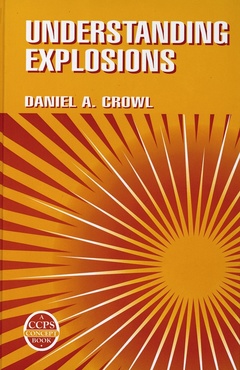Understanding explosions
Auteur : CROWL Daniel A.

Acknowledgments.
Chapter 1. Introduction.
1.1. Accident Loss History.
1.2. The Accident Process (AIChE, 2000)
1.3. A Case History Flixborough, England.
1.4. Hazard Identification and Evaluation.
1.5. Inherently Safer Design.
Chapter 2. Fundamentals of Fires and Explosions.
2.1. Gases and Vapors
2.1.1. Flammability Diagram.
2.1.2. Estimating Flammability Limits.
2.1.3. Temperature Effect on Flammability.
2.1.4. Pressure Effect on Flammability.
2.1.5. Flammability of Gaseous Mixtures.
2.1.6. Minimum Ignition Energies.
2.1.7. Autoignition Temperature.
2.1.8. Example Applications.
2.2. Liquids.
2.2.1. Flashpoints of Mixtures of Liquids.
2.2.2. Example Applications.
2.3. Aerosols and Mists.
2.4. Dusts.
2.5. Hybrid Mixtures.
2.6. Kinetics and Thermochemistry.
2.6.1. Calculated Adiabatic Flame Temperatures (CAFT).
2.6.2. Example Application.
2.7. Gas Dynamics.
2.7.1. Detonations and Deflagrations.
2.7.2. Estimating Peak Side on Overpressures.
2.7.3. Example Applications.
2.7.4. Pressure Piling and Deflagration to Detonation Transition.
2.8. Physical Explosions.
2.8.1. BLEVEs.
2.8.2. Rapid Phase Transition Explosions.
2.9. Vapor Cloud Explosions.
2.9.1. TNT Equivalency.
2.9.2. TNO Multi Energy Method.
2.9.3. Baker Strehlow Tang Method (AIChE, 1999a).
2.9.4. Computational Fluid Mechanics (CFD) Method.
2.9.5. Example Applications.
2.10. Runaway Reactions.
2.10.1. Steady State and Dynamic Reactor Behavior.
2.10.2. Experimental Characterization.
2.11. Condensed Phase Explosions.
2.12. Fireballs, Pool, Flash, and Jet Fires.
2.13. Explosion Effects.
2.13.1. Thermal Exposure.
2.13.2. Overpressure Exposure.
2.14. Ignition Sources.
2.14.1. Static Electricity.
Chapter 3. Prevention and Mitigation of Explosions.
3.1. Additional References.
3.2. Inherently Safer Design.
3.3. Using the Flammability Diagram to Avoid Flammable Atmospheres.
3.4. Inerting and Purging.
3.4.1. Vacuum Purging.
3.4.2. Pressure Purging.
3.4.3. Combined Pressure Vacuum Purging.
3.4.4. Sweep Purging.
3.4.5. Siphon Purging.
3.4.6. Advantages and Disadvantages of the Various Interting Procedures.
3.4.7. Inert Gas Blanketing of Storage Vessels.
3.4.8. Inert Purging and Blanketing during Drumming Operations.
3.5. Example Application.
3.6. Explosion Venting.
3.7. Grounding and Bonding.
3.8. Ventilation.
3.9. Sprinkler and Deluge Systems.
3.10. Charging and Drumming Flammable Liquids.
3.11. Example Application.
3.12. Charging Powders.
3.13. Electrical Equipment in Hazardous (Classified) Areas.
3.13.1. Protection Techniques.
Appendix A. Detailed Equations for Flammability Diagrams.
Part A: Equations Useful for Gas Mixtures.
Part B: Equations Useful for Placing Vessels Into and Out of Service.
Appendix B. Equation for Determining the Energy of Explosion.
B.1. Example Application.
Appendix C. Flammability Data for Selected Materials.
Appendix D. Procedure for Example 3.2.
Appendix E. Combustion Data for Dust...
Date de parution : 04-2003
Ouvrage de 214 p.
15.5x23.5 cm
